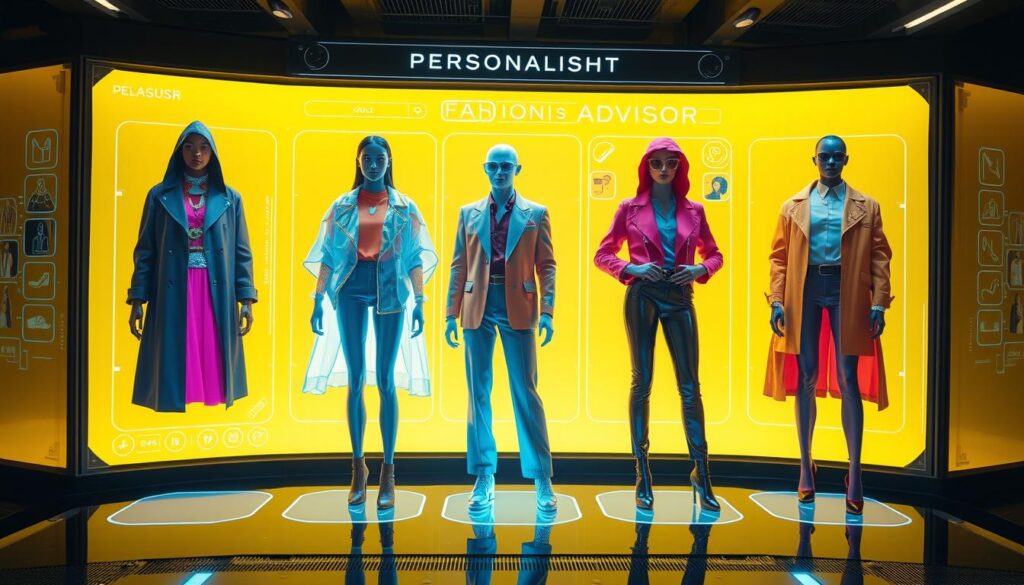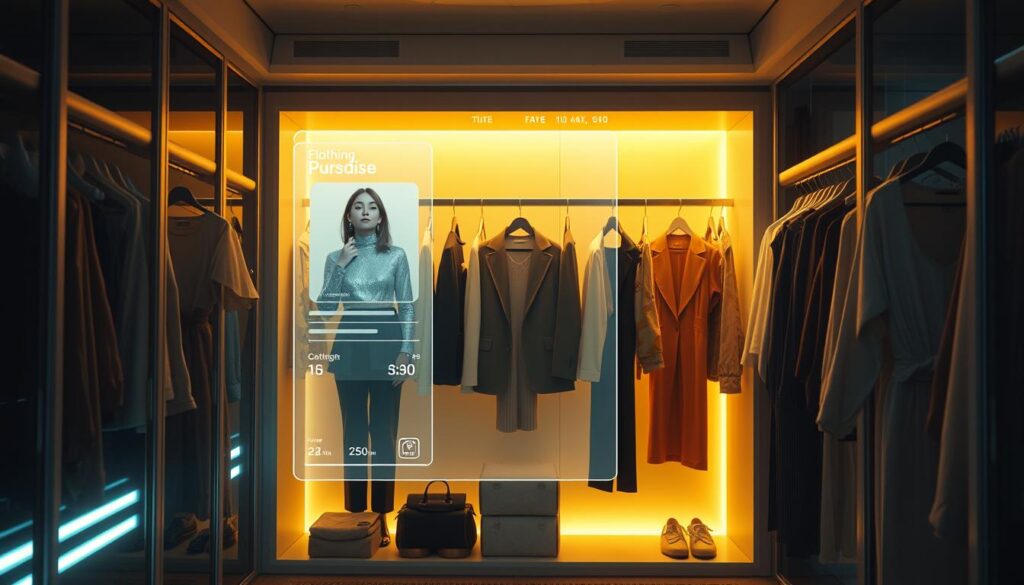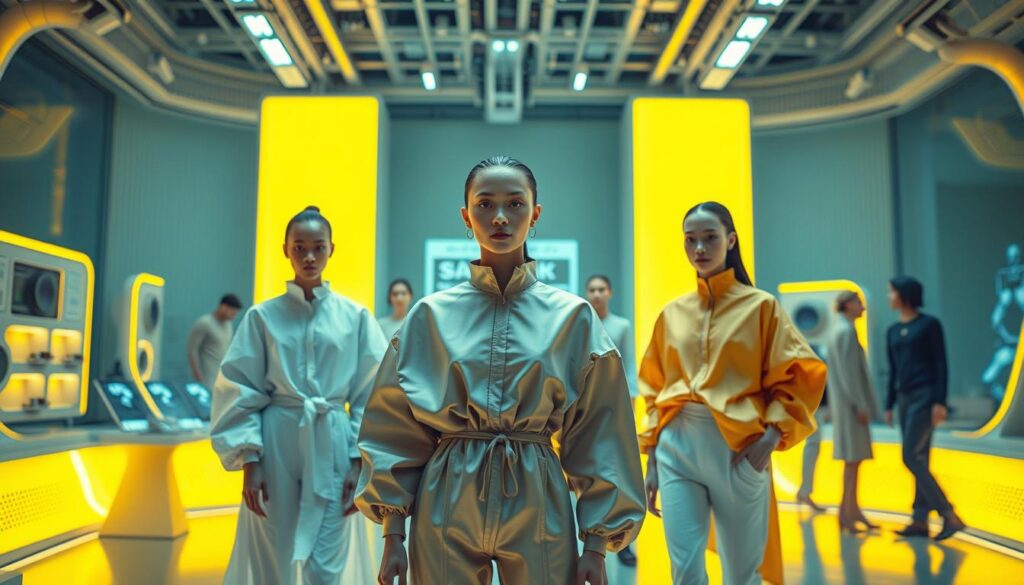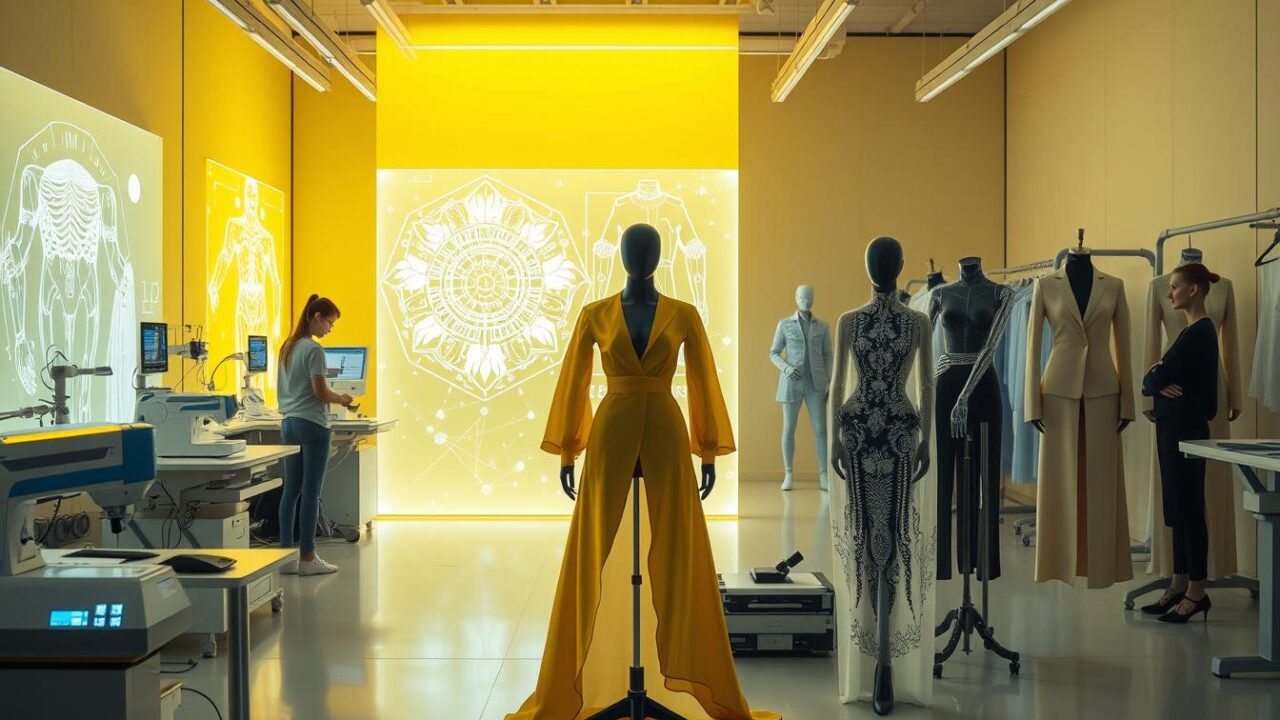Artificial intelligence (AI) is changing the fashion world fast. It will make fashion more personal and sustainable by 2025. We wonder: How will AI change fashion in 2025? And what will it mean for everyone involved?
The AI in fashion market is growing fast. It’s expected to jump from $1.26 billion in 2024 to $1.77 billion in 2025. This shows AI’s big role in fashion. It will help brands make better supply chains, cut waste, and offer custom experiences.
AI fashion assistants will give you style tips based on what you like and your body type. They’ll use lots of data to suggest outfits and shopping trips. By 2025, stores using AI for personal shopping will see a 20% boost in customer happiness.
AI will also help make fashion more eco-friendly. It can make design and production better, cutting down on waste. AI could help reduce production waste by 50% in just five years. This supports greener fashion choices.
Key Takeaways
- AI market size in fashion is projected to reach $1.77 billion by 2025, with a growth rate of 40.4% (CAGR).
- Personalized styling recommendations and virtual try-on technologies will enhance the customer experience.
- AI will support sustainable fashion practices by reducing waste and optimizing production processes.
- Designers will leverage AI as a creative partner, exploring innovative materials and processes.
- Data privacy and ethical concerns regarding AI in fashion will require careful consideration as the technology develops.
The Rise of AI in Fashion

The fashion world is changing fast with the help of artificial intelligence (AI). AI brings new ways to make fashion more personal, green, and creative. With 73% of shoppers expecting brands to understand their tastes and preferences, AI is key for brands to keep up.
AI is making a big difference in personalized fashion recommendations. It uses deep learning to create style profiles for customers. This makes shopping better and keeps customers coming back, with 56% of shoppers more likely to make repeat purchases from brands offering personalized experiences.
AI is also helping make fashion more sustainable. The industry throws away 186 billion pounds of textile waste every year, with 87% of it going to landfills. But AI can help recycle up to 70% of textile waste, making fashion more circular. It can sort through waste to find fibers and contaminants, making recycling better for the planet.
AI is also changing trend forecasting in fashion. It looks at millions of social media images every day to spot new trends. This gives brands insights to make better products and marketing plans.
AI is also making automated garment manufacturing possible. It helps make production more efficient and cuts down on waste. This saves money and helps the environment, making fashion more sustainable.
As AI shapes the future of fashion, brands that use it will stand out. AI helps make fashion more personal, green, and innovative. This makes the fashion world better for customers and the planet.
Personalized Styling and Recommendations

In today’s fast fashion world, people want shopping experiences that fit their style. Artificial intelligence is changing how brands connect with customers. It uses natural language processing and machine learning to understand what each person likes.
With this tech, brands can offer shopping experiences that really speak to each customer. In fact, 73% of shoppers want brands to know their tastes. Companies like Stitch Fix are leading the way by learning up to 90 things about what customers like.
Increased Customer Satisfaction and Loyalty
Personalized shopping experiences make customers happier and more loyal. Studies show 56% of customers will buy from brands that get them. Machine learning helps brands understand what customers want, making shopping better and keeping customers coming back.
Sustainable Fashion through AI
Personalized shopping also helps the environment. AI can predict what customers will buy, reducing waste. The fashion world throws away 186 billion pounds of textiles every year, with most going to landfills. AI can help recycle up to 70% of this waste, making fashion more sustainable.
As AI gets better, fashion will become more personal and green. Brands can make shopping fun and unique while being kind to the planet.
Sustainable Fashion through AI

AI is changing the fashion world for the better. It helps reduce the industry’s environmental harm. Every year, 92 million tons of textile waste are created. AI is making big changes, from improving supply chains to recycling clothes efficiently.
Optimizing Supply Chains
AI is transforming how fashion brands manage their supply chains. It uses smart algorithms to predict demand better. This means less waste and more sold items.
Did you know 30% of clothes worldwide are never sold? That’s a lot of waste. AI helps brands make better choices with data.
Reducing Textile Waste
The fashion world creates a lot of waste, with only 12% of clothes recycled. Polyester, a common fabric, takes 200 years to break down. AI is working to solve this problem.
New tech, like machine learning textiles, sorts fabrics for recycling. This makes recycling clothes more efficient.
Enabling Efficient Recycling
AI is also making recycling better. It can sort waste to recycle up to 70% of materials. This helps create a closed-loop fashion system.
Looking to 2025, AI will be key in making fashion more sustainable. It’s a big step towards a greener future.
“AI has the potential to revolutionize the fashion industry, driving sustainability and reducing waste. It’s not just about technology; it’s about using innovation to create a better future for all.” – Sarah Thompson, Fashion Sustainability Expert
AI-Assisted Design and Creativity
In 2025, artificial intelligence will change fashion forever. AI is now a key partner for designers, helping them create amazing styles. It uses computer vision apparel and deep learning trend forecasting to innovate.
Designers use AI for new print designs, better pricing, and improving customer service. Cala is leading the way with an AI tool that turns text or images into beautiful designs. This is a big step for AI in fashion.
AI as a Creative Partner
Working with AI, designers are making incredible things. Tommy Hilfiger teamed up with IBM and the Fashion Institute of Technology. They use AI to predict trends faster. This lets designers focus on their ideas while AI handles the hard work.
Exploring Innovative Materials and Processes
AI is changing what we wear and how it’s made. It helps find new, green materials. AI also makes production better, cutting down waste and pollution.
“AI is empowering designers to push the boundaries of creativity while embracing sustainability. It’s an exciting time for the fashion industry as we witness the convergence of art, technology, and environmental consciousness.” – Sarah Thompson, Fashion AI Expert
The fashion world is growing, and AI is key. With 73% of fashion leaders seeing AI as important, the future is bright. It’s a mix of human talent and AI that will shape fashion.
Data-Driven Trend Forecasting
In the fast-changing world of fashion, being ahead is key to success. Artificial intelligence is changing how brands predict trends. It helps them make smart decisions that improve their supply chains and cut waste. By using predictive analytics, fashion brands can understand what consumers want and how the market is moving.
Old ways of predicting trends were slow and based on guesses. But AI lets brands quickly analyze lots of data from social media, online shops, and news. This way, they can spot what’s becoming popular and talk to their audience better.
Analyzing Social Media and Sales Data
AI tools watch how people interact online to find new trends. They mix past sales data with current trends to guess what’s next. This helps brands stay ahead and manage their stock better, cutting down on waste.
“Generative AI could potentially add up to $275 billion to operating profits in the fashion, apparel, and luxury sectors over a 5-year period.” – McKinsey
Identifying Emerging Trends
Fashion trends now change fast, in weeks, not years. AI helps brands keep up by spotting new trends quickly. Tools like C2 Trend give forecasts for planning, with updates on the latest fashion.
- Project Muze by Zalando and Google made 40,424 fashion designs in its first month.
- Heuritech checks over 3 million social media images daily for fashion insights, spotting more than 2,000 fashion details to guess what people will want.
By using AI for trend forecasting, fashion brands can lead the way and make the industry better. AI helps make production more efficient, waste less, and meet consumer needs better. As fashion keeps changing, AI will be key to its future.
AI in Circular Fashion and Resale
The fashion world is moving towards being more green, and AI is helping a lot. By 2025, AI will change how we shop for second-hand clothes. It will make sustainable shopping easier than ever.
AI is key in this change through intelligent fashion assistants. These tools help brands keep track of clothes from start to finish. They find ways to fix, sell, or recycle clothes, making them last longer. Digital tools like inventory systems are also being used to cut down on waste and improve efficiency.
AI also helps with personalized fashion recommendations. It matches buyers with sellers in the resale market. This makes it easier to find clothes that fit your style and needs. So, you can shop second-hand with confidence, knowing AI has checked the clothes’ quality.
Extending Garment Lifespans
Circular fashion aims to keep clothes in use for as long as possible. AI helps brands track their products’ life cycles. Digital tools like inventory systems are being used to reduce waste and improve efficiency.
AI finds ways to fix or recycle clothes, reducing waste. This helps clothes last longer and cuts down on textile waste.
Facilitating Sustainable Shopping
AI makes sustainable shopping easier and more appealing. It offers personalized fashion recommendations, connecting buyers with sellers. This makes finding second-hand clothes that fit your style easy.
More people are choosing second-hand fashion. They trust AI to check the clothes’ condition and quality.
“AI-powered curation and search tools are being recognized as effective in helping customers discover brands and products more efficiently, which could encourage greater purchase intent.”
But, there are still challenges. Fake issues and dupe culture on social media are big problems. Yet, companies are focusing more on being green. They aim to pollute less and use less water and energy, leading to a greener future in fashion.
Enhancing Customer Experience with Virtual Sizing
AI is changing how we shop online. It solves the big problem of not being able to try on clothes before buying. This leads to a lot of returns and unhappy customers. But, AI-powered virtual sizing is making a big difference, improving the ai impact fashion sector 2025.
Google’s AI try-on feature for Google Shopping is a great example. It lets customers see how clothes fit on different body types. This makes them more confident in their purchases. It also means fewer returns and happier customers.
AI’s role in virtual sizing is huge. PwC says IVR shopping could add $1.5 trillion to the global economy by 2030. Brands using IVR might see more customers and fewer returns. Zara’s AI-powered fitting rooms have also made online shopping better, with more confident customers and fewer returns.
AI is also making personalization better. Stitch Fix uses AI to suggest clothes based on what customers like. This leads to fewer returns and happier customers. By using machine learning textiles and customer data, brands can offer clothes that fit perfectly.
The ai impact fashion sector 2025 will be big. AI-generated virtual models will help brands show off different body types without expensive photoshoots. AI and IoT are also creating smart clothes that change with the environment and even charge devices. This opens up new markets.
AI in virtual sizing and personalization is making shopping better and greener. It helps brands cut down on waste and make their supply chains more efficient. As the ai impact fashion sector 2025 grows, we’ll see even more cool uses of AI. This will help both customers and the planet.
AI-Generated Photorealistic Content
In 2025, the fashion world is changing fast with AI-generated images. This new tech is changing how designers work, market, and show off their designs. It opens up new possibilities that were hard to imagine before.
AI models like Generative Adversarial Networks (GANs) can make very detailed and real-looking images. By 2025, 75% of fashion design will use AI to be more creative, efficient, and green.
Applications in Digital Art and Illustration
AI is changing digital art and illustration in fashion. Designers can now make amazing visuals that mix reality and fantasy. AI helps artists create detailed textures, realistic lighting, and expressions, letting them explore new ideas in fashion illustration.
Enhancing Advertising and Marketing
The fashion world is using AI to change ads and marketing. Deep learning trend forecasting helps brands guess what trends will come next, improving accuracy by 60%. This lets them make ads that really speak to their audience.
AI also makes e-commerce better by suggesting products based on what you’ve bought before. This makes customers happier and more likely to buy. The market for AI in ads and digital content is growing fast, showing a move towards using AI for quick, high-quality images and animations.
Immersive Augmented and Virtual Reality Experiences
AI is making augmented and virtual reality in fashion even more real. Brands can create 3D models and spaces that feel real. This lets customers explore virtual showrooms and try on clothes in a fun, personal way.
“AI-powered virtual try-on technology has been shown to increase customer purchase rates by 20% as customers feel more confident in their choices.”
Looking ahead to 2025, AI-generated images are going to change fashion in big ways. They will push digital art, improve ads, and make AR/VR experiences more real. But, we need to think about the ethics and make rules for using this tech responsibly in computer vision apparel.
Hyper-Personalization: Tailoring Designs for Individual Shoppers
Artificial intelligence (AI) is changing the fashion world. By 2025, AI will make designs fit each shopper’s taste. It uses data like what you buy and what you like on social media to create just for you.
Studies show 44% of people think AI makes shopping better. Also, 58% say AI has made online shopping better. And 52% might use AI to pick clothes, feeling more confident in their choices.
Leveraging User Data for Personalized Experiences
Using data is key to making shopping personal. By 2025, 66% of shoppers want their data used to make shopping better. AI has been helping with this for 25 years, making shopping more relevant.
Customized E-commerce and Retail
AI is changing how we shop online. With AI, you can try on clothes virtually. This makes buying clothes online more likely, reducing returns.
Personalized Content Creation
AI is also changing how we make content. It can automate tasks, making teams work better. By 2025, AI will make shopping even more personal, changing the fashion world.
But, there are concerns about privacy and too much personalization. Finding a balance between personalization and privacy is important. By 2025, shopping might be more tailored, changing how we interact with fashion brands.
ai impact fashion sector 2025
The fashion world is about to change a lot by 2025, thanks to artificial intelligence (AI). AI will change how fashion brands work and talk to customers. Intelligent fashion assistants and personalized fashion recommendations are becoming more common. For example, over five million people have used Alibaba’s AI assistant, Wenwen, since it started in September 2023.
AI will also help make supply chains better and cut down on waste. Desigual’s “On Demand” model shows how AI can help make fashion more sustainable. It has made four collections with AI, cutting down on extra stock.
Generative AI tools are expected to make fashion production more efficient. They could help reduce waste by avoiding the need for extra stock. This is important because online sales returns cost the fashion industry $212 billion in 2022.
“AI-powered tools are projected to enhance demand forecasting and inventory management, improving operational efficiency.” – Fashion Industry Analyst
AI is also making fashion design more creative. H&M’s ‘Creator Studio’ lets customers work with designers, blending tech and creativity. AI can help designers come up with new ideas by mixing different styles and testing them in real-world conditions.
As AI becomes more common in fashion, rules are changing too. The European Union is creating laws for AI, including in the fashion industry. Schools like LIM College are teaching students about working with AI in fashion.
Brands that use AI will likely lead the fashion market. By 2025, AI and human creativity will change fashion. They will make it more personal, sustainable, and efficient.
Conclusion
Looking ahead to 2025, AI’s role in fashion is clear. Machine learning in textiles and computer vision in apparel are changing everything. Fashion brands can cut task time by up to 50% and save 30% on costs.
AI is making shopping better with personalized advice and virtual try-ons. These tools boost sales by 10-15% and cut returns by 20-25%. AI also helps predict trends with 15-20% more accuracy, leading to successful launches.
AI is also making fashion more green by improving supply chains and reducing waste. As AI skills in fashion grow, those who use these technologies will thrive. Investing in AI talent and focusing on sustainability will open new doors for growth.
Want to hire me as a Consultant? Head to Channel as a Service and book a meeting.

